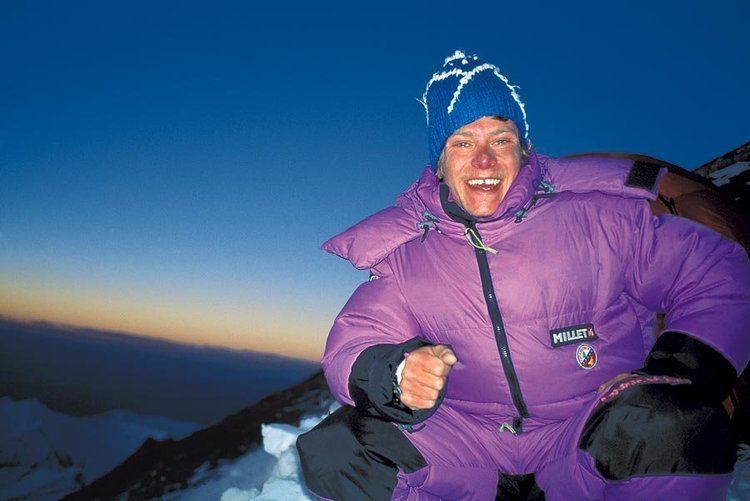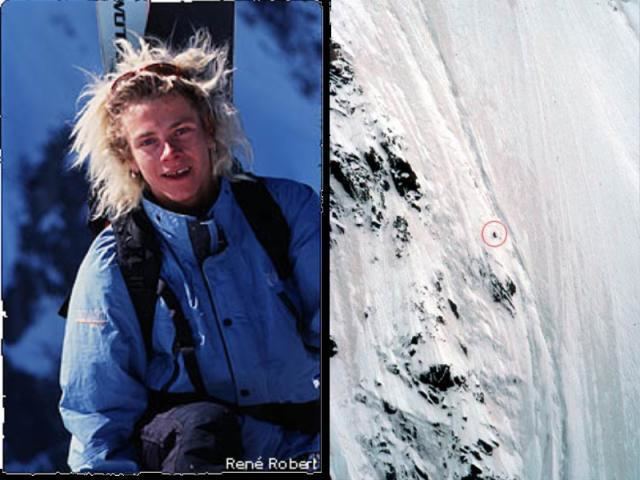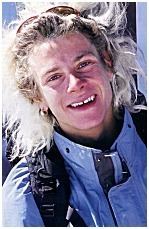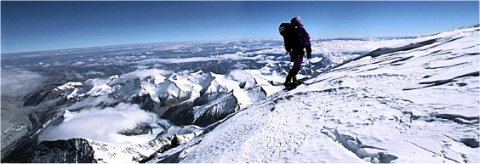Name Marco Siffredi Role Mountaineer | ||
 | ||
Born 22 May 1979 (age 22), Chamonix, France Died 8 September 2002 (aged 22 ), Mount Everest Similar Jean Marc Boivin, Tom Hornbein, Patrick Vallençant | ||
Soir e hommage marco siffredi vendredi 27 f vrier 18h
Marco Siffredi (22 May 1979 – 8 September 2002) was a French snowboarder and mountaineer who hailed from a climbing family; his father was a mountain guide and his brother had died in an avalanche in Chamonix. He was the first to descend Mount Everest on a snowboard in 2001 via the Norton Couloir. In 2002, he disappeared after making his second successful Everest summit, while attempting to snowboard the Hornbein Couloir.
Contents
- Soir e hommage marco siffredi vendredi 27 f vrier 18h
- Le mallory aiguille du midi marco siffredi bertrand delapierre snowboard chamonix mont blanc 6700
- First Snowboard descent at Nant Blanc
- First Everest descent
- Second Everest descent
- Other achievements
- References

Le mallory aiguille du midi marco siffredi bertrand delapierre snowboard chamonix mont blanc 6700
First Snowboard descent at Nant Blanc

In his early years, Marco Siffredi went from strength to strength, racking up more first descents in the Chamonix valley before extending his horizons to bigger peaks. In June of 1999, Marco Siffredi did his first snowboard descent and second-ever descent of the highly coveted Nant Blanc on the Aiguille Verte. The Nant Blanc is a 1,000-meter line averaging 55 degrees with sections of 60 degrees. At that time it had never been repeated following Jean-Marc Boivin’s epic ski descent in 1989. Good conditions on lines like that are rare, and it was certainly one of the cherries that many of the hard guys in the valley talked about picking, but very few of them were actually capable of doing so. Rene Robert’s photos of the descent are awe-inspiring, and for those few who still thought of Marco as just another snowboard punk, the descent solidified his place among the world’s best extreme snowboarders.
First Everest descent

Siffredi reached the summit of Everest, a 29,035-foot mountain, on May 23, 2001 with the help of oxygen along with two Sherpas who brought the equipment.

Siffredi was forced to choose an alternative route to the one he considered the "Holy Grail" of snowboarding, as the coveted Hornbein Couloir did not have enough snow. Instead, he rode down the Norton Couloir for the historic ride back to Advanced Base Camp (ABC) at the foot of the North Col. Then began the descent down the Norton Couloir of the north face, but after only 200 meters a fastening strap on his snowboard broke due to the intense cold (- 35 °C). After repairing it with help from a sherpa, Siffredi continued the descent to 6,400 meters in two hours.

The day before, on May 22, the Austrian Stefan Gatt reached the summit alone and without using oxygen. He went on a snowboard up to 8,600 meters along the north wall, but at that altitude he found very hard snow and decided to continue without snowboarding; the quota of 7,500 meters using shooting snowboarding, going up to 6,450 meters. There were disputes about who would be awarded the first snowboard descent of Everest, as Stefan Gatt got out first, but did not use a snowboard for about 1,000 m. The site everestnews.com, attributed primacy to Siffredi but the site snowboarding.transworld.net, recognized merits and demerits to both, so the record was shared.
Second Everest descent
Early in August 2002, Siffredi departed for Nepal, intending to make the first snowboard descent of Everest along the Hornbein passage. It was late in the season for summitting Everest, but Siffredi hoped that the passage would have more snow. On August 10, he left Kathmandu with three sherpa (Phurba, Pa Nuru and Da Tenzing), reaching base camp (BC) in Tibet on August 14. On September 7, the group reached the advanced field at 8,300 m. On Sept. 8, 2002, after a grueling 12-hour push, Siffredi and the sherpas reached the summit at 2:10 PM. According to Phurba Tashi, however, Siffredi showed little enthusiasm for the accomplishment, commenting that he was "Tired, tired...too much climbing..."
After weather conditions began to change, the Sherpas urged Siffredi not to go. Siffredi ignored their warnings and after only an hour's rest, began making his way towards the Hornbein just after 3pm. His sherpa companions lost sight of him periodically. At the North Col, about 1,300 meters below Camp Three, both Sherpas reported seeing the distant image of a man stand up, then slide silently down the mountain. As they reached the point of the sighting, Siffredi's snowboard tracks were not to be seen. His body has not been found.
Other achievements
Highlights of his career on the north face of Everest.
In May 1996 Siffredi snowboards down the north face of the Aiguille du Midi on Mont Blanc along the Mallory track, a descent of 1,000 meters with passages of more than 50-degree incline.
In 1998, in preparation for climbing the Himalayas, scales Tocilarajo in Peru (6,032 m) with Philippe Forte and René Robert, then falls from snowboard.
On 17 June 1999 makes the first snowboard descent of the Nant Blanc wall of Aiguille Verte on Mont Blanc, with passages of more than 55-degree incline. In autumn of the same year scales Dorje Lhakpa (6,988 m) in Nepal and makes the first snowboard descent of this mountain.
In June 2000 Siffredi scales Huayna Potosi (6,088 m) in Bolivia. In autumn, scales Cho Oyu in the Himalayas; at 8,201 m, the sixth highest mountain on Earth.
In autumn 2001 scales Shisha Pangma, Himalayas (8,027 m) with the intention of making the entire descent by snowboard, but strong winds begin and he is only able to use a portion of the 7,000 m.
